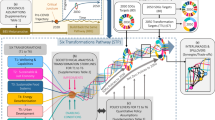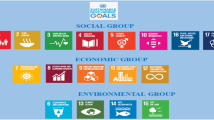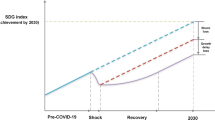Abstract
Sustainable development depends on decoupling economic growth from resource use. The material footprint indicator accounts for environmental pressure related to a country’s final demand. It measures material use across global supply-chain networks linking production and consumption. For this reason, it has been used as an indicator for two Sustainable Development Goals: 8.4 ‘resource efficiency improvements’ and 12.2 ‘sustainable management of natural resources’. Currently, no reporting facility exists that provides global, detailed and timely information on countries’ material footprints. We present a new collaborative research platform, based on multiregional input–output analysis, that enables countries to regularly produce, update and report detailed global material footprint accounts and monitor progress towards Sustainable Development Goals 8.4 and 12.2. We show that the global material footprint has quadrupled since 1970, driven mainly by emerging economies in the Asia-Pacific region, but with an indication of plateauing since 2014. Capital investments increasingly dominate over household consumption as the main driver. At current trends, absolute decoupling is unlikely to occur over the next few decades. The new collaborative research platform allows to elevate the material footprint to Tier I status in the SDG indicator framework and paves the way to broaden application of the platform to other environmental footprint indicators.
This is a preview of subscription content, access via your institution
Access options
Access Nature and 54 other Nature Portfolio journals
Get Nature+, our best-value online-access subscription
$29.99 / 30 days
cancel any time
Subscribe to this journal
Receive 12 digital issues and online access to articles
$119.00 per year
only $9.92 per issue
Buy this article
- Purchase on Springer Link
- Instant access to full article PDF
Prices may be subject to local taxes which are calculated during checkout



Similar content being viewed by others
Data availability
All data have been deposited at https://ielab.info/resources/datasets. Material footprint data are freely available. Multiregion input–output data are available on request only because of the large file sizes.
References
Sustainable Development Goals: 17 Goals to Transform our World (United Nations, 2015).
Wiedmann, T. O. et al. The material footprint of nations. Proc. Natl Acad. Sci. USA 112, 6271–6276 (2015).
Ivanova, D. et al. Quantifying the potential for climate change mitigation of consumption options. Environ. Res. Lett. 15, 093001 (2020).
Steininger, K. W., Lininger, C., Meyer, L. H., Muñoz, P. & Schinko, T. Multiple carbon accounting to support just and effective climate policies. Nat. Clim. Change 6, 35–41 (2016).
Afionis, S., Sakai, M., Scott, K., Barrett, J. & Gouldson, A. Consumption‐based carbon accounting: does it have a future? Wiley Interdiscip. Rev. Clim. Change 8, e438 (2017).
IAEG-SDGs—Tier Classification for Global SDG Indicators (United Nations, 2019).
Tier Classification for Global SDG Indicators (United Nations, 2021).
Lenzen, M., Moran, D., Kanemoto, K. & Geschke, A. Building Eora: a global multi-region input–output database at high country and sector resolution. Econ. Syst. Res. 25, 20–49 (2013).
Lenzen, M., Kanemoto, K., Moran, D. & Geschke, A. Mapping the structure of the world economy. Environ. Sci. Technol. 46, 8374–8381 (2012).
Handbook on Supply, Use and Input–Output Tables with Extensions and Applications (UNSD, 2018).
Giljum, S., Bruckner, M. & Martinez, A. Material footprint assessment in a global input–output framework. J. Ind. Ecol. 19, 792–804 (2015).
Wu, R., Geng, Y. & Liu, W. Trends of natural resource footprints in the BRIC (Brazil, Russia, India and China) countries. J. Clean. Prod. 142, 775–782 (2017).
Pothen, F. A structural decomposition of global raw material consumption. Ecol. Econ. 141, 154–165 (2017).
Giljum, S. et al. Identifying priority areas for European resource policies: a MRIO-based material footprint assessment. J. Econ. Struct. 5, 17 (2016).
Tukker, A. et al. Environmental and resource footprints in a global context: Europe’s structural deficit in resource endowments. Glob. Environ. Change 40, 171–181 (2016).
Steinmann, Z. J. N. et al. Headline environmental indicators revisited with the global multi‐regional input–output database EXIOBASE. J. Ind. Ecol. 22, 565–573 (2018).
Bjelle, E. L. et al. Adding country resolution to EXIOBASE: impacts on land use embodied in trade. J. Econ. Struct. 9, 14 (2020).
Lutter, S., Giljum, S. & Bruckner, M. A review and comparative assessment of existing approaches to calculate material footprints. Ecol. Econ. 127, 1–10 (2016).
Eisenmenger, N. et al. Consumption-based material flow indicators—comparing six ways of calculating the Austrian raw material consumption providing six results. Ecol. Econ. 128, 177–186 (2016).
Bringezu, S. in Managing Water, Soil and Waste Resources to Achieve Sustainable Development Goals: Monitoring and Implementation of Integrated Resources Management (eds Hülsmann, S. & Ardakanian, R.) 11–34 (Springer, 2018).
Giljum, S. et al. The impacts of data deviations between MRIO models on material footprints: a comparison of EXIOBASE, Eora, and ICIO. J. Ind. Ecol. 23, 946–958 (2019).
Teixidó-Figueras, J. et al. International inequality of environmental pressures: decomposition and comparative analysis. Ecol. Indic. 62, 163–173 (2016).
Schaffartzik, A., Duro, J. A. & Krausmann, F. Global appropriation of resources causes high international material inequality—growth is not the solution. Ecol. Econ. 163, 9–19 (2019).
Södersten, C.-J., Wood, R. & Wiedmann, T. The capital load of global material footprints. Resour. Conserv. Recycl. 158, 104811 (2020).
Berrill, P., Miller, T. R., Kondo, Y. & Hertwich, E. G. Capital in the American carbon, energy, and material footprint. J. Ind. Ecol. 24, 589–600 (2020).
Jin, Y., Wang, H., Fry, J., Wang, Y. & Lenzen, M. Material footprints of Chinese megacities. Resour. Conserv. Recycl. 174, 105758 (2021).
Ye, Q. et al. Linking the environmental pressures of China’s capital development to global final consumption of the past decades and into the future. J. Environ. Sci. Technol. 55, 6421–6429 (2021).
Haberl, H. et al. A systematic review of the evidence on decoupling of GDP, resource use and GHG emissions, part II: synthesizing the insights. Environ. Res. Lett. 15, 065003 (2020).
Fix, B. Dematerialization through services: evaluating the evidence. BioPhys. Econ. Resour. Qual. 4, 6 (2019).
Capellán-Pérez, I., de Castro, C. & Miguel González, L. J. Dynamic energy return on energy investment (EROI) and material requirements in scenarios of global transition to renewable energies. Energy Strategy Rev. 26, 100399 (2019).
Keyßer, L. T. & Lenzen, M. 1.5 °C degrowth scenarios suggest the need for new mitigation pathways. Nat. Commun. 12, 2676 (2021).
Piñero, P., Heikkinen, M., Mäenpää, I. & Pongrácz, E. Sector aggregation bias in environmentally extended input output modeling of raw material flows in Finland. Ecol. Econ. 119, 217–229 (2015).
de Koning, A. et al. Effect of aggregation and disaggregation on embodied material use of products in input–output analysis. Ecol. Econ. 116, 289–299 (2015).
Kovanda, J., Weinzettel, J. & Schoer, K. What makes the difference in raw material equivalents calculation through environmentally extended input–output analysis? Ecol. Econ. 149, 80–87 (2018).
Wood, R. et al. Growth in environmental footprints and environmental impacts embodied in trade: implications for resource efficiency. J. Ind. Ecol. 22, 553–564 (2018).
Cibulka, S. & Giljum, S. Towards a comprehensive framework of the relationships between resource footprints, quality of life, and economic development. Sustainability https://doi.org/10.3390/su12114734 (2020).
Zheng, X., Wang, R., Wood, R., Wang, C. & Hertwich, E. G. High sensitivity of metal footprint to national GDP in part explained by capital formation. Nat. Geosci. 11, 269–273 (2018).
Links Between Business Accounting and National Accounting (UNSD, 2000).
Bringezu, S. et al. Multi-scale governance of sustainable natural resource use—challenges and opportunities for monitoring and institutional development at the national and global level. Sustainability 8, 778 (2016).
European Parliament Resolution of 10 February 2021 on the New Circular Economy Action Plan 2020/2077(INI) (European Parliament, 2021).
Ekvall, T., Hirschnitz-Garbers, M., Eboli, F. & Śniegocki, A. A systemic and systematic approach to the development of a policy mix for material resource efficiency. Sustainability 8, 373 (2016).
Ivanova, D. et al. Quantifying the potential for climate change mitigation of consumption options. J. Environ. Res. Lett. 15, 093001 (2020).
Hubacek, K. et al. Global carbon inequality. Energy Ecol. Environ. 2, 361–369 (2017).
Bolea, L., Duarte, R. & Sanchez-Choliz, J. Exploring carbon emissions and international inequality in a globalized world: a multiregional-multisectoral perspective. Resour. Conserv. Recycl. 152, 104516 (2020).
Wang, H. & Zhou, P. Assessing global CO2 emission inequality from consumption perspective: an index decomposition analysis. J. Ecol. Econ. 154, 257–271 (2018).
Leontief, W. Input–Output Economics (Oxford Univ. Press, 1966).
Leontief, W. in Studies in the Structure of the American Economy (eds Leontief, W. et al.) 93–115 (Oxford Univ. Press, 1953).
Leontief, W. W. & Strout, A. A. in Structural Interdependence and Economic Development (ed. Barna, T.) 119–149 (Macmillan, 1963).
Isard, W. Interregional and regional input–output analysis, a model of a space economy. Rev. Econ. Stat. 33, 318–328 (1951).
Leontief, W. Structure of the world economy: outline of a simple input–output formulation. Am. Econ. Rev. 64, 823–834 (1974).
Tukker, A. & Dietzenbacher, E. Global multiregional input–output frameworks: an introduction and outlook. Econ. Syst. Res. 25, 1–19 (2013).
Murray, J. & Lenzen, M. The Sustainability Practitioner’s Guide to Multi-Regional Input–Output Analysis (Common Ground, 2013).
Kanemoto, K. & Murray, J. in The Sustainability Practitioner’s Guide to Input-Output Analysis (eds Murray, J. & Wood, R.) 167–178 (Common Ground, 2010).
Kanemoto, K., Lenzen, M., Peters, G. P., Moran, D. & Geschke, A. Frameworks for comparing emissions associated with production, consumption and international trade. Environ. Sci. Technol. 46, 172–179 (2012).
Leontief, W. & Ford, D. Environmental repercussions and the economic structure: an input–output approach. Rev. Econ. Stat. 52, 262–271 (1970).
Isard, W. et al. On the linkage of socio-economic and ecologic systems. Pap. Reg. Sci. Assoc. 21, 79–99 (1967).
SDG Indicators: Metadata Repository (UNSD, 2018); https://unstats.un.org/sdgs/metadata/
Material Footprint, Material Footprint per Capita, and Material Footprint per GDP Indicator 8.4.1 (UNSD, 2018); https://unstats.un.org/sdgs/metadata/files/Metadata-08-04-01.pdf
Material Footprint, Material Footprint per Capita, and Material Footprint per GDP Indicator 12.2.1 (UNSD, 2018); https://unstats.un.org/sdgs/metadata/files/Metadata-12-02-01.pdf
System of Environmental-Economic Accounting 2012: Applications and Extensions (United Nations, 2017); https://seea.un.org/sites/seea.un.org/files/ae_final_en.pdf
System of Environmental-Economic Accounting 2012: Applications and Extensions; 85–87 (United Nations, 2017); https://seea.un.org/sites/seea.un.org/files/ae_final_en.pdf
System of Environmental-Economic Accounting 2012: Applications and Extensions; 45–59 (United Nations, 2017); https://seea.un.org/sites/seea.un.org/files/ae_final_en.pdf
Lenzen, M. et al. The Global MRIO Lab—charting the world economy. Econ. Syst. Res. 29, 158–186 (2017).
Global Material Flows Database Version 2021 (UN IRP, 2021).
Geschke, A. & Hadjikakou, M. Virtual laboratories and MRIO analysis—an introduction. Econ. Syst. Res. 29, 143–157 (2017).
Lenzen, M. et al. Compiling and using input–output frameworks through collaborative virtual laboratories. Sci. Total Environ. 485–486, 241–251 (2014).
Lenzen, M. et al. New multi-regional input–output databases for Australia—enabling timely and flexible regional analysis. Econ. Syst. Res. 29, 275–295 (2017).
Wiedmann, T. An input–output virtual laboratory in practice—survey of uptake, usage and applications of the first operational IELab. Econ. Syst. Res. 29, 296–312 (2017).
Global Material Flows and Resource Productivity: Assessment Report for the UNEP International Resource Panel (UNEP, 2016).
Technical Annex for Global Material Flows Database (UN IRP, 2018); http://www.csiro.au/~/media/LWF/Files/CES-Material-Flows_db/Technical-annex-for-Global-Material-Flows-Database.pdf
Inomata, S. & Owen, A. Comparative evaluation of MRIO databases. Econ. Syst. Res. 26, 239–244 (2014).
Moran, D. & Wood, R. Convergence between the Eora, WIOD, EXIOBASE, and OpenEU’s consumption-based carbon accounts. Econ. Syst. Res. 26, 245–261 (2014).
Lenzen, M. et al. The carbon footprint of global tourism. Nat. Clim. Change 8, 522–528 (2018).
Acknowledgements
This work was financially supported by the Australian Research Council (ARC) through its projects DP0985522, DP130101293, DP190102277, LE160100066 and DP200102585 (M. Lenzen, A.G., J.F. and A.M.), as well as the National eResearch Collaboration Tools and Resources project (NeCTAR) through its Industrial Ecology Virtual Laboratory infrastructure VL 201 (M. Lenzen, A.G., J.F., A.M. and T.W.), by the United Nations Environment Programme International Resource Panel (IRP) work stream on metrics, data and indicators (M. Lenzen, A.G., J.W. and H.S.), by the United Nations Environment Programme Life Cycle Initiative that—together with the One Planet Network and the UN-IRP—commissioned the development of the online tool SCP-HAT (Agreement ref. DTIE17-SC052, DTIE19-SC042, DTIE20-SC042) (M. Lenzen, A.G., S.G., P.P., S.L., M.S. and H.S.) and by the European Research Council (ERC) under the European Union’s Horizon 2020 research and innovation programme (grant agreement no. 725525) (S.G. and S.L.) . We thank S. Juraszek for expertly managing the Global MRIO Lab’s advanced computation requirements, C. Jarabak for help with collecting data and K. Hosking for editorial services. The views expressed in this article are those of the authors and do not necessarily reflect those of the various affiliated organisations.
Author information
Authors and Affiliations
Contributions
H.S. and M. Lenzen designed the study; M. Lenzen, A.G., J.W., J.F. and M. Li performed the analysis; S.L., S.G. and P.P. reviewed the analysis; M. Lenzen, A.M. and H.S. wrote the manuscript; J.P., I.T., L.M.C., M.V.V., M.S., K.N. and T.W. reviewed the manuscript and contributed to the manuscript.
Corresponding author
Ethics declarations
Competing interests
The authors declare no competing interests.
Additional information
Peer review information Nature Sustainability thanks the anonymous reviewers for their contribution to the peer review of this work.
Publisher’s note Springer Nature remains neutral with regard to jurisdictional claims in published maps and institutional affiliations.
Supplementary information
Supplementary Information
Supplementary Information 1–9, Figs. 1–23, Tables 1–7 and References.
Rights and permissions
About this article
Cite this article
Lenzen, M., Geschke, A., West, J. et al. Implementing the material footprint to measure progress towards Sustainable Development Goals 8 and 12. Nat Sustain 5, 157–166 (2022). https://doi.org/10.1038/s41893-021-00811-6
Received:
Accepted:
Published:
Issue Date:
DOI: https://doi.org/10.1038/s41893-021-00811-6
This article is cited by
-
Wish You Were Here? The Economic Impact of the Tourism Shutdown from Australia’s 2019-20 ‘Black Summer’ Bushfires
Economics of Disasters and Climate Change (2024)
-
China’s safe and just space during 40 years of rapid urbanization and changing policies
Landscape Ecology (2024)
-
A cross-country analysis of sustainability, transport and energy poverty
npj Urban Sustainability (2023)
-
Ecologically unequal exchanges driven by EU consumption
Nature Sustainability (2023)
-
Assessing the United Nations sustainable development goals from the inclusive wealth perspective
Scientific Reports (2023)



